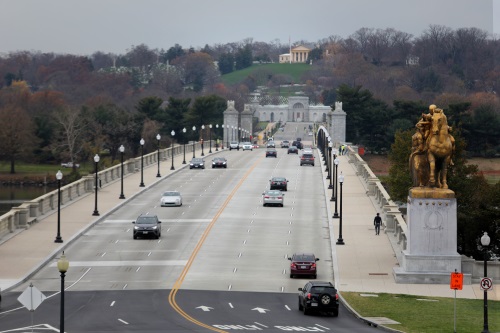The U.S. Department of Transportation and the U.S. Department of the Interior completed a three-year, $277 million renovation of the 2,613-foot-lon Arlington Memorial Bridge that links Washington D.C. directly to Arlington National Cemetery in Northern Virginia.
[Above Photo by Liz Macro/National Park Service.]
First opened to traffic in 1932, the neoclassical-designed Arlington Memorial Bridge carries an estimated 68,000 vehicles a day – making it one of the most important commuter bridges in the mid-Atlantic region, USDOT noted in a statement.

The three-year renovation project – the bridge’s first major repair effort in nearly a century – repaired the bridge’s concrete arches and stone facades on 10 approach spans, replaced the bascule span’s 4 million-pound steel superstructure with a 2.6-million-pound fixed steel span, and resurfaced all its travel lanes.
The Arlington Memorial Bridge project also served as a laboratory of sorts for a variety of construction techniques.
First, a “design-build” contract governed the renovation – meaning the contractor was responsible for both the design and construction of the repairs – which kept project costs to a minimum and shaved more than a year off construction time.
The project also used accelerated bridge construction techniques to remove 200,000 square feet of bridge decking and replace it with precast concrete deck panels connected with ultra-high performance concrete, to remove and replace more than 60,000 square feet of sidewalks, and refurbish more than 5,000 pieces of granite.
The National Park Service said in a statement that throughout construction it took “special care” to protect Arlington Memorial Bridge’s historic architecture while enhancing its iconic appearance. Since physical work began in fall 2018, construction workers methodically removed, cleaned, repaired and reinstalled more than 4,500 pieces of granite and rehabilitated the bridge’s historic structure.
In addition to completing Arlington Memorial Bridge’s first ever total rehabilitation, the NPS implemented recommendations from a safety study of Memorial Circle by repaving, improving crossings, adding new signs and making the area easier and safer for drivers, pedestrians and bicyclists to navigate.
 Nation
Nation


